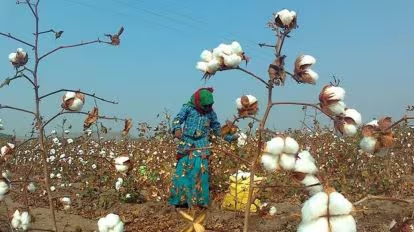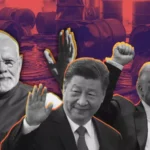India Sacrifices Cotton Farmers as Trump Tariffs Force Removal of Import Duty
With just days remaining for a new cotton harvest the Modi government has decided to gift the Prime Minister’s and “India’s friend Do-land Trump” (Donald Trump) our cotton farmers. Apparently, under the US’s pressure of 50% tariffs, India has decided to remove 10% import duty on cotton from 19th August to September 30th 2025. This import duty effectively increased the price of foreign grown cotton by 11%.
Interestingly, the elimination of the import duty comes within a fortnight of Prime Minister Narendra Modi had said that India will never compromise on the interest of farmers.
Addressing the MS Swaminathan Centenary International Conference in Delhi, Modi had said on August 7 in Hindi, “Farmers’ interest is our top priority. India will never compromise on the interest of farmers, fisherfolks and dairy farmers. Personally, I know that I will have to pay a big price for this, but I am ready for it.”
The elimination of import duty and the 40 day relaxation for foreign cotton importers is being welcomed by industries as they get access to cheaper cotton for their machines, and further pushes the local prices down. Meanwhile the government loses around Rs. 170 crore in revenue.
While the Cotton corporation of India (CCI) endorses this import duty removal, in reality they may suffer upwards of Rs. 700 crores reportedly from previously held cotton stocks from last years. This move also has a huge impact on local traders who have withheld their cotton stocks from last year hoping for higher prices this year.
But why will they suffer losses? The new dumping of mainly US cotton will destroy local prices, because cotton will be in over-supply and foreign cotton will be able to challenge the local farmers due to the reduction of the import duty.
Currently CCI’s selling rate for cotton is between Rs. 56,000 to 57,000 per candy (355.6 kg) while after the removal of the duty imported cotton will tentatively cost between Rs. 50,000 to Rs. 51,000 per candy. Now cotton minimum support price (MSP) for the current harvest was supposed to be Rs 61,000, but with the new imported stock, cotton farmers would have to be lucky to achieve this price realisation.
It is reported that sources within the textile ministry opposed the removal of import duty, but the industry is singing praises for this move because it gets them cheaper foreign cotton and break the domestic market price by at least Rs 6,000. Plus it also kills any chance of market prices going beyond the projected MSP.
Laissez-faire or fare trade?
For a second now lets see this from the farmers’ perspective. The cotton cultivating regions of Telangana, Maharashtra, Punjab, etc in India are one of the highest indebted region in the country, surprisingly a very high percentage of all farmers’ suicides are from the cotton growing belts, with Marthawada and Vidarbha topping the list on farmers suicides. A special investigation team of the Maharashtra government termed even called “Bt cotton as a killer crop” because it is responsible for the maximum number of dead farmers.
In recent years, affected by erratic weather and higher input costs, cotton farmers have been demanding a higher MSP for cotton from Punjab to Maharashtra. But instead of helping them out, the Modi government has sacrificed them for the bigger deal with the Trump administration.
Meanwhile in the US, President Trump is winning hearts among his farmer electorate by creating new markets for American commodities. He is acting in alignment with age old foreign policy objective of the USA, “find markets for US surpluses”. But that is not all, the US government is giving a massive subsidies to its cotton growers.
In 2024, the US government gave $9.3 billion in subsidy payments to farmers for commodity crops. Subsidies made up 5.9% of total farm earnings that year, with the most funding going to corn, soybeans, and cotton. Additionally it was reported that the “US disbursed $40.10 billion in cotton subsidies during 1995-2020”. The impact of the US subsidies was so huge that it titled the global cotton prices to Uncle Sam’s liking. For example in 2011 US cotton growers received a $24 billion subsidy.
Furthermore, Trump administration announced $60 billion in subsidies for farmers over the next decade in the recent tax bill and there is high probability of US growers getting export subsidies or income support to make their commodities more competitive in the global market.
So, basically the Trump administration is artificially subsidising US agri products making them cheaper and then dumping them on developing countries to break the local markets. The case of cotton is good example, as India, which is one of the largest producers of cotton, has to now accept US cotton under geopolitical pressure and has to sacrifice her cotton farmers for potential gains with the Trump administration. While Trump empowers their farmers, Modi government is sacrificing our most vulnerable farmers.
Politically speaking this could also have a big impact on the popularity of the areas which are considered as the strongholds of the Rashtriya Swayamsevak Sangh (RSS). Maharashtra is a major hub of RSS backed politicians, and a price crash could directly impact the politicians seeking votes from the cotton farmers. Big political leaders like Devendra Fadnavis, Nitin Gadkari, etc. who are considered close to the RSS, could be the direct collaterals to this policy.
Genetically modified cotton varieties could be threat to biodiversity
But that is not all, underneath the threat of tariffs could be lurking the next challenge of opening our fields to third and fourth generation genetically modified cotton varieties markets by US based companies like Monsanto. This could be the next big attack on our biodiversity and cotton farming.
One should keep in mind that the BT cotton varieties are toxin producing seeds which are bio engineered to produce a known toxin called bacillus thuringensis (bt) which could be devastating to biodiversity and the food system. The newer generations of GMO also require extensive use of carcinogenic pesticides. The Bt cotton seeds land up in our food system through the use extensive use in cottonseed oil which is now being used extensively in making of industrial namkeens, chips, and other snack and food items.
Once the tariff game begins to work favourably for the Trump administration, he will definitely choose an America first policy which would empower not only American farmers but also American corporations.
The question now remains what can the Modi government do to prevent this hostile takeover of our farmers, import policy and national sovereignty, from the current standpoint – only acquiesce.
Also Read: Russian Oil Imports: Why the U.S. Targets India but Spares China








